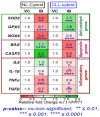Using Human 'Personalized' Cybrids to Identify Drugs/Agents That Can Regulate Chronic Lymphoblastic Leukemia Mitochondrial Dysfunction
- PMID: 37446202
- PMCID: PMC10341973
- DOI: 10.3390/ijms241311025
Using Human 'Personalized' Cybrids to Identify Drugs/Agents That Can Regulate Chronic Lymphoblastic Leukemia Mitochondrial Dysfunction
Abstract
This study uses personalized chronic lymphoblastic leukemia (CLL) cybrid cells to test various drugs/agents designed to improve mitochondrial function and cell longevity. Age-matched control (NL) and CLL cybrids were created. The NL and CLL cybrids were treated with ibrutinib (Ibr-10 μM), mitochondrial-targeted nutraceuticals such as alpha lipoic acid (ALA-1 mM), amla (Aml-300 μg), melatonin (Mel-1 mM), resveratrol (Res-100 μM) alone, or a combination of ibrutinib with nutraceuticals (Ibr + ALA, Ibr + Aml, Ibr + Mel, or Ibr + Res) for 48 h. MTT (3-(4,5-dimethylthiazolyl-2)-2,5-diphenyltetrazoliumbromide), H2DCFDA(2',7' Dichlorodihydrofluorescein diacetate), and JC1 assays were used to measure the cellular metabolism, intracellular ROS levels, and mitochondrial membrane potential (∆ψm), respectively. The expression levels of genes associated with antioxidant enzymes (SOD2, GPX3, and NOX4), apoptosis (BAX and CASP3), and inflammation (IL6, IL-1β, TNFα, and TGFβ) were measured using quantitative real-time PCR (qRT-PCR). CLL cybrids treated with Ibr + ALA, Ibr + Aml, Ibr + Mel, and Ibr + Res had (a) reduced cell survivability, (b) increased ROS production, (c) increased ∆ψm levels, (d) decreased antioxidant gene expression levels, and (e) increased apoptotic and inflammatory genes in CLL cybrids when compared with ibrutinib-alone-treated CLL cybrids. Our findings show that the addition of nutraceuticals makes the CLL cybrids more pro-apoptotic with decreased cell survival compared with CLL cybrids exposed to ibrutinib alone.
Keywords: chronic lymphoblastic leukemia; cybrid; ibrutinib; mitochondria; nutraceutical.
Conflict of interest statement
All authors declare that they have no competing interest. The funders had no role in the design of the study; in the collection, analyses, or interpretation of data; in the writing of the manuscript, or in the decision to publish the results.
Figures








References
-
- Stauder R., Eichhorst B., Hamaker M.E., Kaplanov K., Morrison V.A., Österborg A., Poddubnaya I., Woyach J.A., Shanafelt T., Smolej L., et al. Management of chronic lymphocytic leukemia (CLL) in the elderly: A position paper from an international Society of Geriatric Oncology (SIOG) Task Force. Ann. Oncol. 2017;28:218–227. doi: 10.1093/annonc/mdw547. - DOI - PubMed
MeSH terms
Substances
Grants and funding
LinkOut - more resources
Full Text Sources
Medical
Research Materials
Miscellaneous

